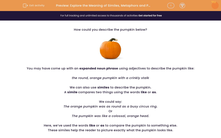How could you describe the pumpkin below?

You may have come up with an expanded noun phrase using adjectives to describe the pumpkin like:
the round, orange pumpkin with a crinkly stalk
We can also use similes to describe the pumpkin.
A simile compares two things using the words like or as.
We could say:
The orange pumpkin was as round as a busy circus ring.
Or
The pumpkin was like a colossal, orange head.
Here, we’ve used the words like or as to compare the pumpkin to something else.
These similes help the reader to picture exactly what the pumpkin looks like.
We can also use metaphors to describe the pumpkin.
Metaphors compare one thing to another without using the words like or as.
Metaphors compare by saying one thing is actually something else.
We could say:
The orange pumpkin was a round circus ring.
Or
The pumpkin was a giant orange head.
Can you see how we’ve changed the similes into metaphors by removing the words like and as?
In addition to similes and metaphors, we can also use personification to add description to writing.
Personification is where we bring an object, or part of an object, to life by giving it human features.
We could say:
The wrinkled pumpkin demanded that I pick it.
We have personified the pumpkin by giving it wrinkles.
We have also personified the pumpkin by saying that it demanded that I should pick it. Pumpkins can’t make demands. That’s only humans!

Similes, metaphors and personification are all types of language devices.
Read the first verse of the pumpkin poem.
Which language device can you spot here?
Pumpkins
In fields of gold, they start to grow,
Round pumpkins in a neat row.
Their vines reach out like greedy hands,
Creating autumn's orange lands.

Did you spot the simile in the third line?
Their vines reach out like greedy hands.
By comparing the vines to greedy hands, the reader can picture the shape of the vines and how several are sprouting out of the ground like fingers. This is the effect or impact of the device.
This is much better than simply saying that there were a lot of vines!
In this activity, you’ll be on the hunt for similes, metaphors and personification and what effect these might have on a reader.

If you are ready, let's get started.








